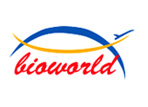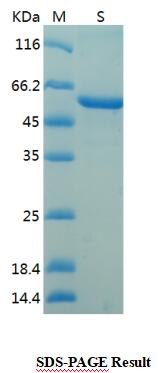Product Name :
CD115/CSF1R Recombinant Protein Swiss-Prot :
P07333 Host :
E.coli Tag :
≥0.5mg/ml Amino acid Sequence :
IPVIEPSVPELVVKPGATVTLRCVGNGSVEWDGPPSPHWTLYSDGSSSILSTNNATFQNTGTYRCTEPGDPLGGSAAIHLYVKDPARPWNVLAQEVVVFEDQDALLPCLLTDPVLEAGVSLVRVRGRPLMRHTNYSFSPWHGFTIHRAKFIQSQDYQCSALMGGRKVMSISIRLKVQKVIPGPPALTLVPAELVRIRGEAAQIVCSASSVDVNFDVFLQHNNTKLAIPQQSDFHNNRYQKVLTLNLDQVDFQHAGNYSCVASNVQGKHSTSMFFRVVESAYLNLSSEQNLIQEVTVGEGLNLKVMVEAYPGLQGFNWTYLGPFSDHQPEPKLANATTKDTYRHTFTLSLPRLKPSEAGRYSFLARNPGGWRALTFELTLRYPPEVSVIWTFINGSGTLLCAASGYPQPNVTWLQCSGHTDRCDEAQVLQVWDDPYPEVLSQEPFHKVTVQSLLTVETLEHNQTYECRAHNSVGSGSWAFIPISAGAHTHPPDEFLFTP Restriction sites :
NdeI-XhoI Background :
Macrophage-colony stimulating factor (M-CSF, CSF-1) receptor is an integral membrane tyrosine kinase encoded by the c-fms proto-oncogene. M-CSF receptor is expressed in monocytes (macrophages and their progenitors) and drives growth and development of this blood cell lineage. Binding of M-CSF to its receptor induces receptor dimerization, activation, and autophosphorylation of cytoplasmic tyrosine residues used as docking sites for SH2-containing signaling proteins. There are at least five major tyrosine autophosphorylation sites. Tyr723 (Tyr721 in mouse) is located in the kinase insert (KI) region. Phosphorylated Tyr723 binds the p85 subunit of PI3 kinase as well as PLCγ2. Phosphorylation of Tyr809 provides a docking site for Shc (5). Overactivation of this receptor can lead to a malignant phenotype in various cell systems. The activated M-CSF receptor has been shown to be a predictor of poor outcome in advanced epithelial ovarian carcinoma and breast cancer. Soluble :
PBS, 4M Urea, PH7.4 Purification&Purity :
Transferred into competent cells and the supernatant was purified by NI column affinity chromatography and the purity is > 85% (by SDS-PAGE). Storage&Stability :
Store at 4°C short term. Aliquot and store at -20°C long term. Avoid freeze-thaw cycles. Expression vector :
pet-22b(+) BiowMW :
~55kDa Note :
For research use only, not for use in diagnostic procedure. concentration :
≥0.5mg/ml
CD115/CSF1R Recombinant Protein Swiss-Prot :
P07333 Host :
E.coli Tag :
≥0.5mg/ml Amino acid Sequence :
IPVIEPSVPELVVKPGATVTLRCVGNGSVEWDGPPSPHWTLYSDGSSSILSTNNATFQNTGTYRCTEPGDPLGGSAAIHLYVKDPARPWNVLAQEVVVFEDQDALLPCLLTDPVLEAGVSLVRVRGRPLMRHTNYSFSPWHGFTIHRAKFIQSQDYQCSALMGGRKVMSISIRLKVQKVIPGPPALTLVPAELVRIRGEAAQIVCSASSVDVNFDVFLQHNNTKLAIPQQSDFHNNRYQKVLTLNLDQVDFQHAGNYSCVASNVQGKHSTSMFFRVVESAYLNLSSEQNLIQEVTVGEGLNLKVMVEAYPGLQGFNWTYLGPFSDHQPEPKLANATTKDTYRHTFTLSLPRLKPSEAGRYSFLARNPGGWRALTFELTLRYPPEVSVIWTFINGSGTLLCAASGYPQPNVTWLQCSGHTDRCDEAQVLQVWDDPYPEVLSQEPFHKVTVQSLLTVETLEHNQTYECRAHNSVGSGSWAFIPISAGAHTHPPDEFLFTP Restriction sites :
NdeI-XhoI Background :
Macrophage-colony stimulating factor (M-CSF, CSF-1) receptor is an integral membrane tyrosine kinase encoded by the c-fms proto-oncogene. M-CSF receptor is expressed in monocytes (macrophages and their progenitors) and drives growth and development of this blood cell lineage. Binding of M-CSF to its receptor induces receptor dimerization, activation, and autophosphorylation of cytoplasmic tyrosine residues used as docking sites for SH2-containing signaling proteins. There are at least five major tyrosine autophosphorylation sites. Tyr723 (Tyr721 in mouse) is located in the kinase insert (KI) region. Phosphorylated Tyr723 binds the p85 subunit of PI3 kinase as well as PLCγ2. Phosphorylation of Tyr809 provides a docking site for Shc (5). Overactivation of this receptor can lead to a malignant phenotype in various cell systems. The activated M-CSF receptor has been shown to be a predictor of poor outcome in advanced epithelial ovarian carcinoma and breast cancer. Soluble :
PBS, 4M Urea, PH7.4 Purification&Purity :
Transferred into competent cells and the supernatant was purified by NI column affinity chromatography and the purity is > 85% (by SDS-PAGE). Storage&Stability :
Store at 4°C short term. Aliquot and store at -20°C long term. Avoid freeze-thaw cycles. Expression vector :
pet-22b(+) BiowMW :
~55kDa Note :
For research use only, not for use in diagnostic procedure. concentration :
≥0.5mg/ml
Blocking peptide available as NCP0251P

 CD115/CSF1R Recombinant Protein
CD115/CSF1R Recombinant Protein 
 Datasheet
Datasheet COA
COA MSDS
MSDS SHIP
SHIP